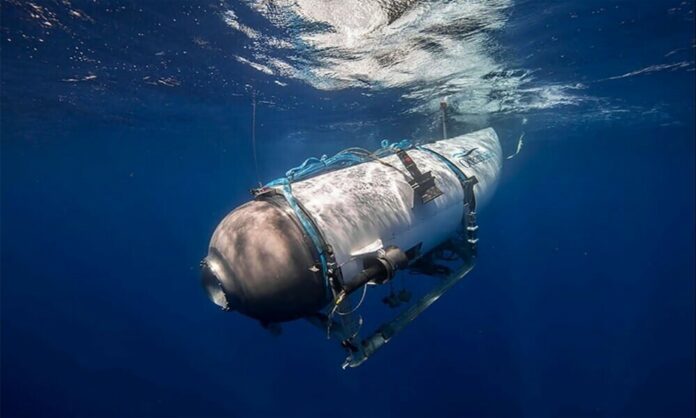A massive search and rescue effort for a missing submersible near the wreck of the Titanic was at a critical stage late on Wednesday, with just hours left before the oxygen supply for the five people on board runs out.
While coast guard officials insisted they remained “hopeful,” with a surge of assets and experts joining the operation and sonar picking up unidentified underwater noises, the challenge of locating and recovering the crew alive appeared increasingly formidable.
All communication was lost with the 21-foot craft during its descent on Sunday to see the remains of the British passenger liner, which sits more than two miles (nearly four kilometers) below the surface of the North Atlantic.

Engro Corp Vice Chairman Shahzada Dawood, his 19-year-old son Suleman, British billionaire Hamish Harding, French explorer Paul-Henri Nargeolet, OceanGate CEO Stockton Rush were on board the craft.
OceanGate Expeditions charges $250,000 for a seat on the sub.
“Sometimes you’re in a position where you have to make a tough decision. We’re not there yet,” said US Coast Guard Captain Jamie Frederick, adding that it remained a search and rescue mission “100 per cent”.
Organisers of the multinational response — which includes US and Canadian military planes, coast guard ships and teleguided robots — are focusing their efforts in the North Atlantic close to multiple “underwater noises” detected by sonar late Tuesday and Wednesday.
The sounds raised hopes that the passengers on the small tourist craft are still alive, though experts have not been able to confirm their source.
“We don’t know what they are, to be frank with you,” said Frederick, who added: “We have to remain optimistic and hopeful.”
Titan began its descent at 8:00am on Sunday and had been due to resurface seven hours later, according to the US Coast Guard.
Rescuers, who have received help from around the world, estimate that passengers may run out of oxygen on Thursday morning, based on the sub’s capacity to hold up to 96 hours of emergency air.
‘Underwater noises being analysed’
Also on board is the company’s CEO, Stockton Rush, and a French submarine operator Paul-Henri Nargeolet, nicknamed “Mr Titanic” for his frequent dives at the site.
Ships and planes have scoured 10,000 square miles (around 20,000 square kilometers) of surface water — roughly the size of Massachusetts — for the vessel, which was attempting to dive about 400 miles off the coast of Newfoundland, Canada.
After the noises were detected by a Canadian P-3 aircraft, rescuers relocated two remotely operated vehicles (ROV) that search under the water and one surface vessel with sonar capability.
The ROV searches have not yielded results but data from the Canadian aircraft has been shared with US Navy experts for acoustics analysis.
“There have been multiple reports of noises and every one of those noises is being analysed,” said Carl Hartsfield, from the Woods Hole Oceanographic Institution.
He added that the sounds “have been described as banging noises”.
Frederick said the number of surface vessels in the search would double from five to 10 within 24 to 48 hours.
The Navy has sent a specialised winch system for lifting heavy objects from extreme depths, other equipment and personnel; and the Pentagon has deployed three C-130 aircraft and three C-17s.“
A deep-sea underwater robot sent by France’s oceanographic institute was due to arrive early on Wednesday afternoon. A Canadian ship carrying medical personnel and a decompression chamber was also en route.
Fears of a leak
Titan’s mission was expected to be the only manned trip to the Titanic this year due to bad weather, Harding wrote in on Instagram beforehand.
The Titanic hit an iceberg and sank in 1912 during its maiden voyage from England to New York with 2,224 passengers and crew on board. More than 1,500 people died.
It was found in 1985 and remains a lure for nautical experts and underwater tourists.
The pressure at that depth as measured in atmospheres is 400 times what it is at sea level.
Mike Reiss, an American television writer who visited the Titanic wreck on the same sub last year, told the BBC the experience was disorientating.
Alistair Greig, professor of marine engineering at University College London, has suggested two possible scenarios based on images of the Titan.
He said if it had an electrical or communications problem, it could have surfaced and remained floating, “waiting to be found” — bearing in mind the vessel can reportedly be unlocked from the outside only.
“Another scenario is the pressure hull was compromised — a leak,” he said in a statement.
“Then the prognosis is not good.”
In 2018, OceanGate Expeditions’ former director of marine operations David Lochridge alleged in a lawsuit that he had been fired after raising concerns about the company’s “experimental and untested design” of the craft.




